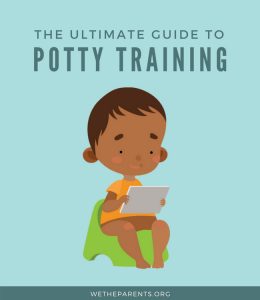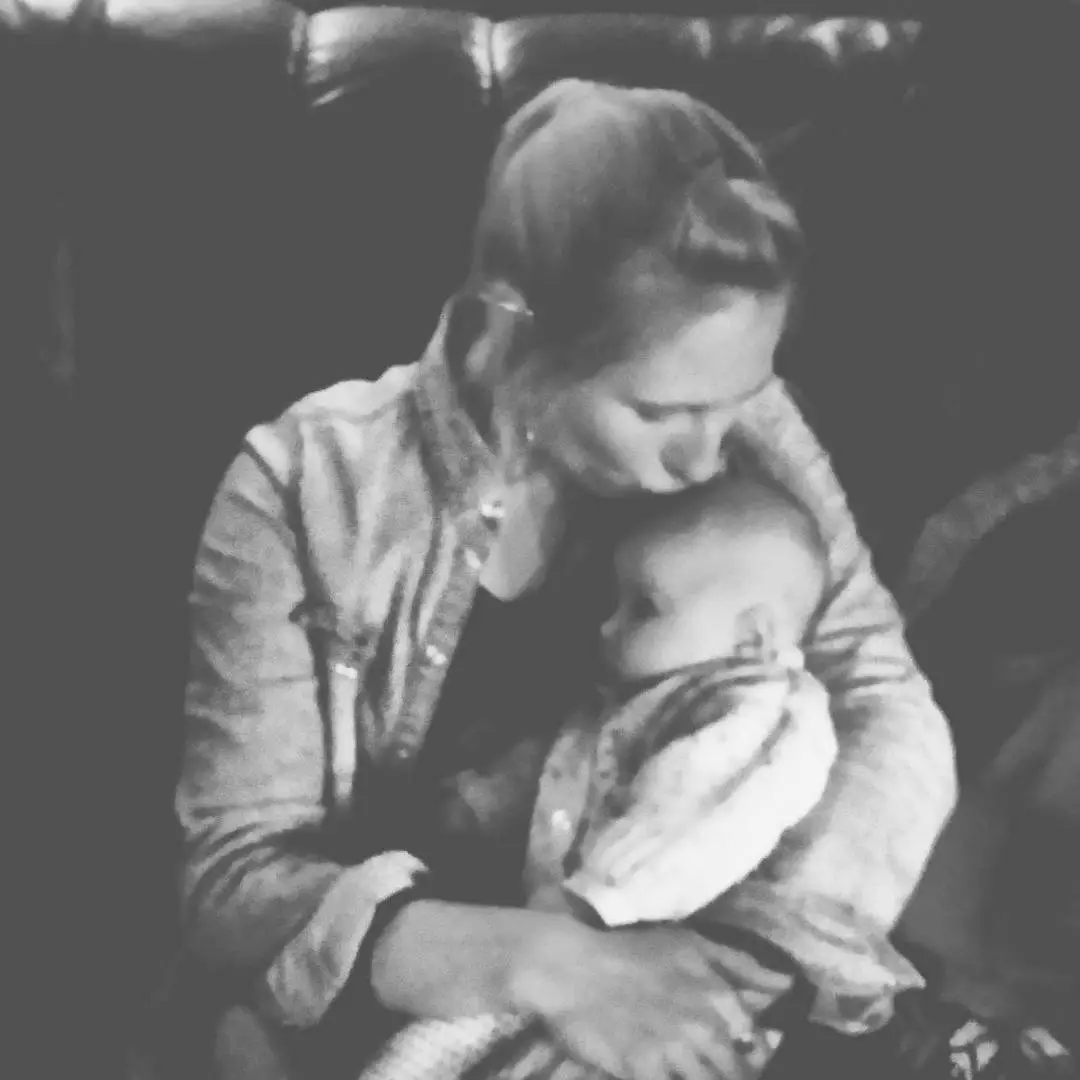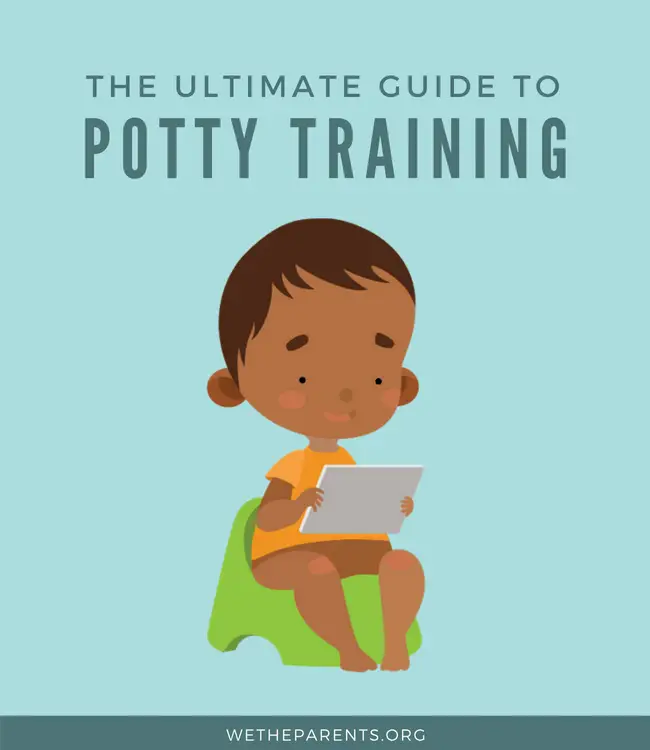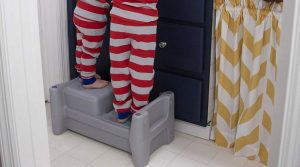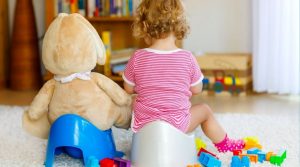Struggling to settle on the best potty training method?
It can certainly be an overwhelming time, and getting a child out of diapers is something that most parents just want done.
Alas, there is no magic word or step-by-step guide that will work for everyone, every time.
However…
There are several battle-tested potty training approaches that we’ll break down for you in this guide. Once you know what you’re working with, it’ll be easy to cherry-pick the best bits and create a bespoke method that will work for you and your family.
Let’s do this!
In this article:
Potty training readiness
Many parents will find themselves introducing the concept of bathroom breaks when their kiddo is between 18 and 30 months old, but that doesn’t mean you should go out of your way to start on the younger side. You could strain the relationship between you and your child by pushing her too far from her comfort zone too soon, or even inadvertently encourage her to hold her bladder and bowels when she shouldn’t. This could lead to health issues, such as urinary tract infections or constipation problems.1Choby, B. A., & George, S. (2008). Toilet training. American Family Physician, 78(9), 1059-1064.
aafp.org
Related: 9 Best Potty Seats & Chairs for Toddlers in 2021
With that said, here is a potty training readiness checklist so that you know with confidence when your child is ready for potty training:

Learn more about potty training readiness: 15 signs your toddler may be ready
Now we’ll break down the potty training readiness checklist in more detail. There are three main areas of development to look out for: Physical, Behavioural, and Cognitive. Here’s what to look for:
Physical signs
#1 She pees a fair amount in one go
Most toddlers will urinate between four and eight times a day. If she is meeting these numbers and releasing more than a spritz of urine in one go, it might be time to take the show to the toilet. Afterall, with regular eliminations that are sizable enough, she will probably be happy to avoid spending time in wet diapers.2Potty training readiness checklist
babycenter.com
#2 Her diapers are dry for at least 2 hrs and after naps
There will come a time when you will be pleasantly surprised that, after your kiddo has just had a good snooze, you are greeted by a well-rested child and a dry diaper. As this starts happening on a more regular basis, you can do your happy dance because your child is learning to control her bowel and bladder muscles.3Potty training readiness checklist
babycenter.com
#3 Her poops are well-formed and regular
If you are looking at your clock and thinking “Ah, this is about the time my little one will need a diaper change”, then congratulations; your kiddo is beginning to form a bathroom schedule. Since pooping on the toilet can be a hurdle (ew, water might splash me there?!), you can use their internal clock to your advantage. Just remember to make sure the poop has been well-formed in their diaper and keep an eye out for constipation issues. 4Signs Your Toddler Is Ready to Be Potty Trained
whattoexpect.com
#4 She can walk, sit, and pull her pants up and down
You will want your kiddo to be able to assist a bit in their own potty training. Afterall, this is a step to encourage their growing autonomy as a person. Being able to remove clothes, make her way to her potty, and even fiddle with a game while she sits on the toilet will engage her in this learning experience.5Azrin, N., & Foxx, R. M. (2019). Toilet training in less than a day. Gallery Books.
kidshealth.org
Related: The 5 Best Urinals for Potty Training in 2021
Behavioral signs
#1 She tugs at wet or soiled diapers
When she starts exhibiting behavior that says “Yuck, get this off of me!” it means she is consciously connecting her dirty diaper as a source of discomfort. Some parents actually switch to cloth diapers at this stage. That’s because they aren’t as effective at “wicking” away the moisture and so your toddler will feel and be more aware of the wetness. The natural next step is to show her that there is a way to avoid that sensation altogether by introducing her to the potty.6Potty training readiness checklist
babycenter.com
#2 She is fascinated by others’ use of the bathroom and wants to imitate
Children are natural mimics. While this might drive you a little nuts while she is developing her vocabulary, it is a true blessing when she expresses an interest in copying Momma’s bathroom habits. The more interest she takes in what you do behind that closed door, the more likely she is ready to try the behavior out for herself. You can show her what you do to complete your own bathroom routine, and she might even want to join in.7Duong, T. H. (2013). Development of bladder control in a population that is potty-trained early-A follow up study in Vietnamese children.
whattoexpect.com)
#3 She makes a physical or verbal sign when doing a poop (like grimacing, squatting, or telling you)
This is a good sign that she is developing the ability to express what is happening with her body, and realizing that eliminations are not something that merely ‘happen’ out of the blue. You want to encourage these acknowledgments as they will make it easier for you to know when to sit her on her potty.8Psychological Readiness and Motor Skills Needed for Toilet Training
healthychildren.org
#4 She is interested in wearing “big kid” underwear
Our kiddos seem to constantly be striving for the perks awarded to their older peers. A new or growing desire to trade her diapers for that cool underwear means she is ready to explore wardrobe options that don’t include diapers and makes them an excellent incentive for using the toilet. Plus, she’ll kiss goodbye to diaper rash.9Toilet Training
aafp.org
#5 She is able to sit calmly for 2 to 5 minutes
While all children (and, let’s face it, most adults) appreciate instant gratification, the reality is that potty training will have a fair amount of waiting on the potty seat. Once she starts demonstrating that she can be seated for a period of time without becoming stressed or fidgety, you can begin introducing her to the concept of sitting on a toilet.10Potty training readiness checklist
www.babycenter.com
#6 She expresses an interest in potty training
You won’t always get a big, clear sign that your child is ready for the next developmental stage, but sometimes you will get lucky. If your little one appears fascinated with all things bathroom related, by all means, encourage her curiosity by acquainting her with a potty chair or seat.11Toilet Training
kidshealth.org
#7 She is in a generally cooperative phase – not an oppositional one!
If your kiddo’s favorite word is currently “NO!” and her favorite actively is stomping her feet and crossing her arms defiantly, you probably won’t want to dive right into toilet training. That is just setting everyone up for failure. You want her in an amenable state of mind before you begin to teach her this particular life skill.12Potty training readiness checklist
babycenter.com
Related: The 9 Best Toddler Step Stools of 2021
Cognitive signs
#1 She understands words about the toileting process
Few things are more helpful than your child having at least a basic understanding of any new life-lesson. Sure, you might feel a little silly repeating things like pee-pee, poopy, or potty over and over, but once you see her begin to recognize the meaning behind such words, it’s a promising signal that she is ready for the next step.13Potty training readiness checklist
babycenter.com
#2 She recognizes the physical sensations of needing to go, and can let you know before it happens
Ah, the Holy Grail of potty training. When your kiddo is going out of her way to give you a heads up that she is feeling the urge to go, and is holding it long enough to let you know, she is almost certainly ready to take a seat on the porcelain throne.14Potty training readiness checklist
babycenter.com
#3 She has begun to put things where they belong
When you see her start to employ the idea that there is a place for everything and everything should be in its place, it won’t come as a shock to her that her poop and pee also belong in a specific location. Potty training can be a culture shock to some kids, so this is a great mental building block to have in place before you move forward. 15Potty training readiness checklist
babycenter.com
#4 She can follow basic directions
Another vital building block is her ability to do as she is told. If you ask her to put her toy in the toy box, but she throws it across the room instead, you might find yourself being met with a quizzical stare when you ask her to sit on a potty seat.16Toilet Training
kidshealth.org
Preparing for Potty Training
So, your kiddo has given you plenty of signs that THEY are ready to work on potty training, but are YOU prepared? Afterall, it’s not just a big step for your toddler; you as the parent need to get your home and, just as importantly, yourself ready for this next big step.
Home set-up
It’s a given that accidents will happen while you potty train. To lower your stress level, take a few precautions to limit their scope and protect expensive home items.
- Protect carpets and furniture with plastic covers;
- Put away area rugs;
- Have several potty chairs and/or seats for easy access;
- Keep a clear path to the potty/potties
Mental and practical preparation
Be sure that your mindset is on the level when you go into potty training. Remember that it won’t happen overnight and be sure to:
- Have a relaxation technique, such as deep breathing, for when things get frustrating;
- Clear your work schedule so that you are not feeling distracted;
- Eat well, stay hydrated;
- Do your cleaning and meal prep before embarking on a rigorous potty training schedule
Get your gear
Depending on your method of preference, you won’t need every item on the market that is geared towards toilet training. However, you might find it useful to invest in:
- A potty seat or potty chair and/or stool;
- Training pants;
- Big-kid underwear;
- Special rewards for potty successes;
- Extra laundry detergent and cleaning supplies;
- Plenty of sheets;
- Mattress cover
Choosing your approach
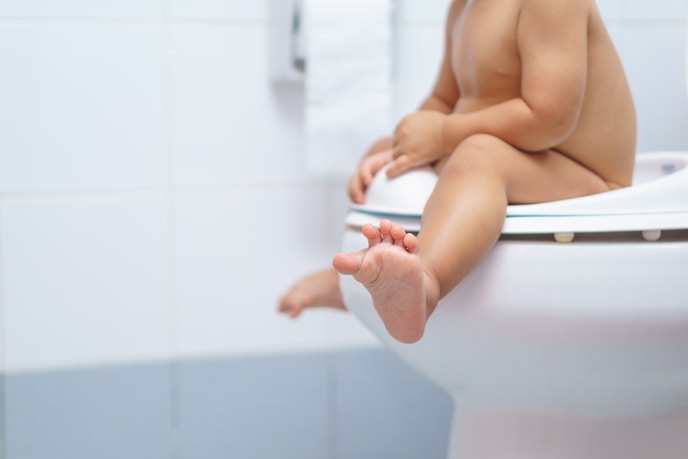
Now that your little one is ready for potty training, and you are more than ready to be off diaper duty, it’s time to choose a technique.
Now, when we say choose an approach, we don’t mean find one method and never stray from its given steps. Potty training is a process and, while you might fall in love with one specific technique and realize that everything about it works for you and your child, don’t be afraid to borrow bits and pieces from another method. It’s all about what works for your family.
With that said, let’s explore some popular potty training programs.
#1 The easy-going toddler-led approach
Many parents find this method appealing because there is no timetable. Fellow advocates of the toddler-led approach will not be howling at the moon if your child isn’t using the toilet like a pro by the time she is four.
The long and short of this method is that you let your kiddo take the lead, you should even ask her directly if she would like to use the toilet or stay in a diaper. If she is resistant to the idea of using her potty, support her choice and move on with your day. That’s not to say that you don’t encourage, teach, and reward in this method, it just means that you respect that your child has a say in their own development.
Plant the bug early
At some point, your child is going to be knocking on the bathroom door, wanting to know what you’re up to in there. Why not invite them on in and take the mystique out of the bathroom.
Explain what you are doing, yes, all of it. Sure, it can be uncomfortable using the toilet with an audience, even if that audience is your own flesh and blood. But, as parents, we will be doing plenty of pride swallowing throughout the years, so it’s a good idea to get used to it now.
Be sure to point out how to wipe, flush, and wash your hands as you complete your bathroom routine. And remember, you want to convey that using the toilet is fun, so do it all with a smile!
Pick a rewards system
You know your child better than anyone on the face of the planet, so what exactly you choose is totally up to you. Just remember, it has to be something (or things) that your kiddo will enjoy several times a day, and we recommend making it a “potty-specific” reward. Of course, you should give praise and prizes for other good behavior, but when she uses the toilet, the super cool stuff should come out.
Do you need to potty?
Whatever variation of this phrase is used in your household, get used to saying it. A lot. Ideally, you want your kiddo to begin acknowledging the changes they start to feel when their bladder or bowels are full.
A game of (porcelain) thrones
Sure, it would be great if, during potty training, every time you asked your kiddo if she needs to use the bathroom she responded “Yes, mother, I would like to go to the bathroom” but I’m pretty sure that only happened once for me. In a dream. A very nice dream, might I add.
Set a timer and be ready to put them on their potty chair or seat every 15 – 20 minutes in the beginning (say, the first week or so) and gradually move to longer increments between sittings.
Play naked
If you are comfortable with this, let your kiddo roam the house naked for a few days, or put them in a long shirt. Sometimes, when a child can see their eliminations exiting their body, they are more likely to identify that these things should not simply be falling on the floor but should be going somewhere.
Naps and night-time
There is nothing wrong with using a diaper for naps or at night. We are moms and dads with busy lives and should never have to apologize for needing a good nights rest. Besides, odds are that your kiddo isn’t chomping at the bit to be woken up several times during the night for a sitting-session.
As your child gets older and has a bit more autonomy about getting in and out of bed, you can try out underwear or training pants that are easy to pull up and down. Then, should she wake up with the urge to go, she can do most of the work herself.
Praise the victories
You want your kiddo to feel as good as you do about using the bathroom. Be sure to sing her praises often, but don’t over-do it. Too many accolades too often can cause them to lose their meaning, or even become irritating to your kiddo.
Don’t punish accidents
Accidents will happen, it’s just a fact of life. When they do, gently acknowledge what happened, mention that our pee and poo have their own place in the house (the toilet), and move right along with your day.17https://www.parentingscience.com/toddler-potty-training.html
#2 The no-nonsense 3-days and done approach
If you like things done quickly and aren’t afraid of the intense schedule that is involved, you will be pleased to know that many parents have found success with this method.
If you go this route, you will want to plan ahead; take time off of work, make sure you have no obligations what-so-ever, pre-make all meals, and be sure that you have plenty of toys and activities to amuse your kiddo during downtime.18https://www.parenting.com/toddler/potty-training/how-3-day-potty-training-method-works
Get up early
You, not your kiddo. You see, you are going to be spending the next three days watching your child as if she were a ticking time bomb of bodily functions. Which, in a way, I suppose all toddlers are.
Make sure you have yourself ready for the day. Brush your teeth, have your coffee, and take a deep breath because it’s going to be a busy one.
Dress for success
Make sure your kiddo is wearing clothing that allows their hiney to have easy toilet access. Long shirts are great, no underpants needed. That said, if you would prefer your kiddo wear an undergarment, sing their praises when they put it on. Afterall, it’s a fun transition to go from diapers to that fun, big kid underwear!
Ditch the diapers – literally!
Some parents will dispose only of the previous night’s diaper, but others prefer to toss the whole lot out. Whichever you decide on, make it a bit of a ceremonial right of passage for your child. It’s a good thing, an exciting thing, to be saying goodbye to diapers!
Don’t ask, tell
Instead of you frequently asking your child if they need to pee or poop, ask her to tell you when she feels the need to go. You will repeat a variation of the phrase “Tell Mommy or Daddy when you need to potty” and she will soon not need any prompting to alert you to her needs.
Toileting trips
Take a stroll to the bathroom every 15 minutes or so for the entire three days. Don’t hyperventilate; we mean literal days. You will not need to spend three nights camped out in the bathroom.
Night-time
While you will be going for longer increments at night, you will still need to set the alarm. Be sure to get up about halfway through the night to check on your kiddo and take her to the bathroom.19https://www.healthline.com/health/parenting/potty-train-in-three-days#4
Hydrate, hydrate, hydrate
Over these next few days, you want your child to become very well acquainted with the feeling of a full bladder. Working towards that goal, you should be passing out water, juice boxes, or another beverage of your choosing, constantly.
Rewards system
Be sure to have a little treat on hand to reward successes. Make sure it is something that your kiddo loves, a sticker or tiny treat, and only give that particular award after a bathroom success. You want to make sure you keep it super special.
Many parents have also had success buying two or three bigger rewards (like a doll, small toy car, or stuffed animal) to give their child after a successful day or night.
Dashing to the toilet
If you catch your child having an accident, don’t get angry. Instead, when possible, pick her up and carry her to the toilet so that she can finish her business in the proper place. If you successfully make it in time, be sure to praise that she at least got some of her pee or poop in the appropriate place.
Don’t get mad
When your kiddo has an accident and you were unable to make it to the toilet at all, don’t get angry. Acknowledge the potty mishap, reiterate where pee and poop belong, take a deep breath, and continue onwards and upwards.
#3 Early potty training a.k.a elimination communication
This is a method that won’t be for everyone, but it does have its perks. You shrink your eco-footprint, save money on diapers, and form a unique bond with your child. If you are up for the commitment, and it will be a tricky one, to partake in this technique, then be prepared for some public push-back in many western countries.
The reason why some people frown on this method is that you are starting when your child is a baby, not when she is older and able to show signs of being ready for potty training.20http://theattachedfamily.com/membersonly/?p=2699
Watch and learn
This observation is best done on a waterproof or easily cleanable surface; messes are unavoidable. As your baby goes about her day, cooing away, nursing, and exploring her environment, you will be watching for the changes that occur when she is ready to potty. Does she suddenly detach from the nipple before she urinates? Does her face get scrunched and red before a bowel movement?
When you are able to pinpoint how your baby acts right before she eliminates, you can begin putting short words or even hand signs to these actions.21http://godiaperfree.com/night-time-ec-tips/
Bathroom time
When you become versed in these pre-potty behaviors, you will want to make your way to the toilet or potty chair. Position your baby over the seat and allow her to do her bathroom-business.
Skip the rewards
Since the philosophy behind this method is that peeing and pooping are natural occurrences, there is no need for constant rewarding. So put away the sticker charts and little candies; your child should view voiding her bladder and bowels as just another part of her day.
No punishments
Although you shouldn’t focus on rewarding a successful bathroom trip, nor should you make a fuss over accidents. If you find yourself getting frustrated, take a deep breath and keep moving forward with the plan.
Night-time
If you choose to forgo diapers altogether, be prepared for many long nights as you and your baby fall into a toileting routine. Be sure to put a waterproof layer over the baby’s crib mattress (or your bed, if you are cosleeping) and hang in there; it is possible to go diaperless even at night.
Mix in diapers
Don’t feel like this technique is all or nothing. You can absolutely use diapers if and when you deem it necessary. Yes, this includes at night; you have not failed if you keep a box of Pampers in your home.
When to stop
If you find yourself getting frustrated to the point of anger, or notice that the bond between you and your baby is becoming one of stress, it’s okay to do a full stop, embrace diapering, and wait to potty-train. Remember; it’s not a race, and your relationship with your baby is the most valuable thing in the world.
The doo-do’s and doo-not’s of potty training
Regardless of how you go about getting your kiddo out of diapers (or never putting them in diapers), there are several rules that, for the most part, cross over to all methods.
DO
- Plan ahead;
- Be patient;
- Model good bathroom habits;
- Allow older siblings to help;
- Learn the signs that your child needs to eliminate;
- Encourage your child to tell you when she needs to potty;
- Allow your child to interact with the potty during play;
- Praise proper potty habits (except when using the Elimination Communication method);
- Acknowledge accidents without anger;
- Choose clothing that is easy to take off and put back on;
- Allow your child to be naked;
- Switch techniques if you need to.22https://www.parentingscience.com/toddler-potty-training.html
DON’T
- Use shaming tactics or punishments;
- Refer to a urinary or bowel movement as “gross” or “disgusting” to your child (but feel free to think it to yourself);
- Withhold beverages;
- Assume what worked for one child will work for another;
- Feel like you are on a potty-training deadline;
- Feel like you need to adhere to one method and one method only;
- Expect immediate results;
- Turn the bathroom into a war of wills.23https://www.whattoexpect.com/toddler/potty-training/how-to-start.aspx
Wrapping up
Potty training is a milestone achievement for our kids, but it’s also a huge accomplishment for us as parents. Just remember that no matter what method you choose, no one, not your friends, not your mother-in-law, not a celebrity personality, can dictate the right or wrong way. It’s all about what works for your family and lifestyle and, we promise, you will have your child potty trained before they walk across the stage to receive their high school diploma.
How did it go for you?
Are you in the middle of potty training? Or perhaps you’ve come out the other side? We’d love to hear any wisdom that you picked during your personal journey. Please share your thought or comment below.
